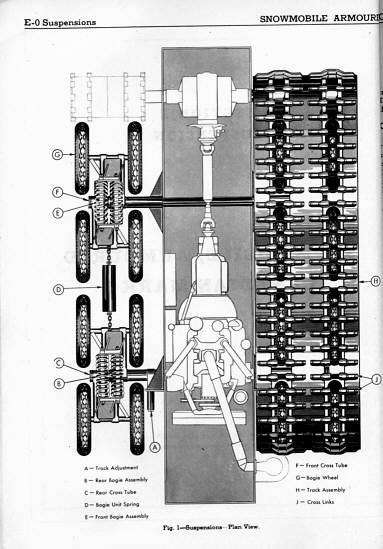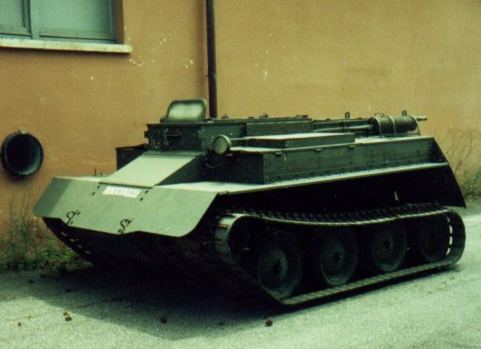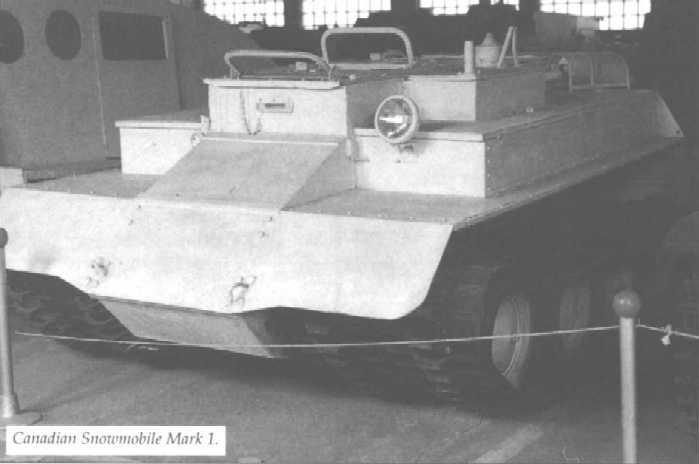Or
the Snowmobile, Armoured, Canadian, Mk.1.
This
page features a selection of quotes from various sources on the subject
plus a number of links to others.

A Survey of Army Research
and Development, 1939-45, p.19-20 (14 Feb. 1955) (Canadian
Army Headquarters Report No.73)
"Typical of
development work particularly suited to Canadian conditions and resources
is the Snowmobile series of low ground pressure vehicles. The development
of these vehicles was supervised by the Army Engineering Design Branch
(A.E.D.B.) of the Department of Munitions and Supply. A survey of commercial
types of snow vehicles was made in the fall and winter of 1941 on the instigation
of the U.N. Following the study complete tests were carried out on the
most promising one of these types, and a military vehicle was developed
therefore by introducing a number of modifications to improve the performance
under service conditions.
Some 129 of
these "Bombardier" snowmobiles were built, starting in the spring of 1942.
Most of the vehicles were shipped to the U.K. At the same time a project
was instituted to develop, from the ground up, a vehicle of similar type
(half track with skis at front), but greater capacity. Interest in this
vehicle ceased in July 1943. However a pilot had been built and during
tests it became apparent that such a vehicle could better be manoeuvred
by means of the tracks than by ski steering. It was decided, therefore,
to build an experimental fully tracked snow vehicle. Tests on the new vehicle
were carried out in the winter of 1942-43, and their success led to a decision
to adopt the full track principle for service snow traversing vehicles.
In the spring
of 1943 the British Ministry of Supply expressed an immediate requirement
for an armoured two-man reconnaissance snowmobile. The results of previous
experience were devoted therefore to satisfying this requirement, rather
than to a plan which had been contemplated of building an unarmoured personnel
and cargo carrying vehicle, and a prototype was built of the vehicle which
became known as the "Snowmobile, Armoured Canadian, Mark 1.". Production
started in early spring 1944 and vehicles having been produced.
Meanwhile,
in January1944, the Ministry of Supply had requested A.E.D.B. to develop
a version of the Snowmobile for hot climate and amphibious operations.
As an interim measure the Mark 1 snowmobile was modified for hot climate
operation, while concurrently experimental work was instituted which led
to the conversion of the snowmobile into the armoured amphibian Mudcat,
of which pilot models were made in the spring of 1945. Design of a lighted
load-carrying version of the Mudcat, subsequently called "Muskrat" began
in October 1944. Pilot models only were produced.
The final
member of the snowmobile family, the Penguin, reverted to the original
oversnow function. With operation "Muskox" impending, work was started
by D.V.S.A. in October 1945 on building, from the Mark 1 Snowmobile, a
mock up of sedan type vehicle in which equipment and personnel could be
transported in reasonable comfort in extreme cold conditions, a requirement
which had been established from the experiences of previous winter exercises.
Following brief tests 15 Penguins were made for the operations.
Operational
user trials were carried out on several Mark 1 Snowmobiles in Italy in
January and February 1945. Performance over all types of soft ground was
excellent. They not only travelled, with ease, roads one and a half feet
deep in mud but were able to assist bogged wheeled vehicles to firm footing.
The mechanical reliability of the vehicles was good.
In operation
"Muskox" (February to May 1946) which covered 3,100 miles under the most
trying conditions of weather and terrain, it was dust which ultimately
proved the worst enemy; during the last 200 miles (36 hours) of running
six engines were knocked out from this
cause."
|
|


|
This suspension plan
view from the maintenance manual shows the layout of the drive train: a
Cadillac V8 petrol engine, coupled to a 4-speed Hydramatic automatic transmission
driving the front sprockets through a Ford T16 Universal carrier axle with
controlled differential steering. The engine and transmission were a proven
combination, as a pair of each was used in the M5A1 Stuart and M24 Chaffee
Light Tanks.
Technical characteristics as listed
in Bart Vanderveen's Fighting Vehicles Directory:
Snowmobile, Canadian, Armoured,
Mk I (Farland & Delorme)
Cadillac V8-cyl, 125 bhp, 4F1R (Hydramatic),
154x101x58 in, 9400 lb. Also known as Car, Armoured, Tracked. Role: Light
Reconnaissance car with crew of two. No. 19 W/T set, Bren and Sten gun
etc. 16 Run Flat tyres (4.50-16); 35-in tracks. |
Survivors
|


|
A
Snowmobile survives in the "Il
Museo storico della Motorizzazione Militare" located at the Caserma
Arpaia, Viale dell'Esercito 170, Roma-Cecchignola, Italy.
Scan courtesy
of Don Dingwall. |
|


|
Another
survivor at the museum at the Museum of Armoured Forces, Kubinka, Russia.
Click
here to see another photo of the Snowmobile at Kubinka.
Scan courtesy
of Don Dingwall. |
|
In
the thread
Penguin
# 8 (on Maple
Leaf Up Forum) Jim Webster (by
way of Gordon McMillan) noted:
-
"Some went
to Yugoslavia [100+] in the late 40's and one was even seen, apparently,
during the late civil war carrying a quad .50cal mount. I spotted that
in an intelligence document and I'll see if I can get an image."
-
"An unknown
quantity were sold to Turkey in 1947 and three survivors are in
a scrapyard somewhere near Amasya if I recall correctly".
|
|
Quotes
from other sources
Don Dingwall, Canadian Armour
in the Italian Campaign:
"One notable Canadian-designed and
produced vehicle that arrived for field tests was the Snowmobile, Armoured,
Canadian, Mark I, often referred to as the Mudcat, and later known as the
Penguin. This remarkable little vehicle was designed as an armoured, two-man
recce vehicle for cold weather regions. This vehicle was the result of
a verbal request by the British Ministry of Supply, and was a development
of a full-tracked unarmoured snowmobile, upon which the Army Engineering
Design Branch had already conducted tests in 1943.
Equipped with a Cadillac V8 engine
coupled to a Hydra-matic automatic transmission, and a Ford T16 Universal
carrier axle with controlled differential steering, this vehicle was tested
by the 5th Armoured Brigade in the first weeks of January 1945, when it
was issued with one M29 Weasel and 12 snowmobiles. With its armoured hull
and ground pressure of only 1.9 pounds per square inch, it not only provided
good fun for the Strathcona's recce troop but proved able to negotiate
all types of mud, sand and snow encountered. It was compared against the
M29 Weasel and the conclusions reached were that the Weasel was fine for
carrying stores but not useful for much else because of its lack of armour,
very short track life, and low horsepower-per-ton ratio of 10.9, compared
to the Canadian snowmobile's 29 hp/ton. The Penguin proved to be an ideal
recce vehicle, with provision for a No. 19 wireless set, a Sten gun, a
rifle and a Bren gun that could be mounted on any of three pivots on the
hull front and sides. It was also tested for bringing forward supplies
to areas previously accessible only by foot or mule, and six-pounder guns
were towed through mud up to the axles with no problems.
For added load-carrying capabilities,
two trailers were designed in the Mediterranean theatre for use with the
snowmobile. One, designed at the Mechanical Experimental Establishment
in Cairo, was based on the tracks and suspension from a Universal carrier
and was quite serviceable. The other was designed in Italy and was found
to sink in soft ground. The British discovered that while the vehicle was
being tested in Egypt of all places, it overheated when operating in temperatures
above 70 degrees F - a fact that was confirmed when the instruction book
finally arrived. In all, 415 of these nimble little vehicles were made.
Of these, three were shipped to Russia, 400 were ordered by the British,
10 by the Department of National Defence, and two Mark Is were supplied
to the Army Engineering Design Branch. Orders were placed for a Mark II
version with improved cooling and better weather protection for all-weather
use. Unfortunately, this was after the major component assemblies were
already out of production. This necessitated a cutback of four vehicles
to the British order, under Contract #UN 4718. The fifth vehicle came under
Canadian Contract #MP 10027. Therefore, the total production was 410 Mark
Is and five Mark IIs. They were not taken on strength by Canadian units
as there was no requirement for them in Canadian units and spring was approaching."
Bill Gregg
writes:
"The vehicle
proved to be one of the best performing vehicles
to be designed during the Second World War. 410 vehicles were produced
in late 1944 and early 1945, 397 of which were delivered to a British contract.
During British
and Canadian trials, it proved to be superior in performance to other Allied
all-terrain vehicles, including the Weasel, in severe mud conditions. As
a six-pounder gun tower, it proved to be superior to all other models in
Allied use at the end of the war.
Laden weight
was just under five tons and, in spite of 14 mm side armour, ground pressure
was just over 1.6 pounds per square inch. It carried a crew of two and
was powered by a Cadillac V8 engine with hydramatic transmission."
-
From David
Fletcher's The Universal Tank (1993):
"Naturally
enough, Canada had considerable experience of building and operating oversnow
vehicles, some of which were of considerable interest to the military.
Marketed as the Snowmobile one developed into an armoured carrier powered
by a Cadillac V8 engine, and seem to have proved suitable for all ground
and weather conditions, since a sample vehicle was tested over mud and
swamps by MEE in Italy and shortly after the war another was used experimentally
on the otherwise impassable sand sea of the Quattara Depression in, of
all places, the Sahara Desert!"
The accompanying
picture shows armoured Snowmobile Z5874162, painted overall white and marked
"WVEE 1307", "on test in Britain".
-
From the AEDB
DESIGN RECORD 1945:
"ORDERS
Contract ~
Requisition Number ~ File No. ~ Qty
UN 3110 ~
AID/GB - 1 ~ BSB-2827 (PC2621) ~ 400
UN 11 ~ AID/USSR
- 2 ~ P-187-2 ~ 2
MP 5458 ~
MSX/292 ~ PE-134-292 ~ 2
MP 5459 ~
CD/LV - 2535 ~ 20/LV7-85 Army ~ 10
Approximate
cost per vehicle $8000.00"
Further
reading on the subject
For more information, follow the
links to some web sites and forum messages:
With special thanks to Don Dingwall,
Colin McGregor Stevens and Geoff Winnington-Ball for their assistance in
compiling this page.
|
Page
created: 13-Dec-2002 | Last revision: 18-May-2004 | Copyright ©
1999-2004 H.L.
Spoelstra - All Rights Reserved
|





